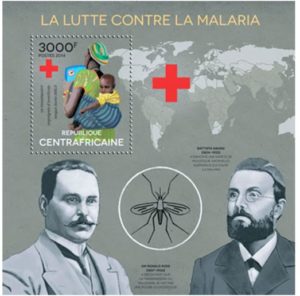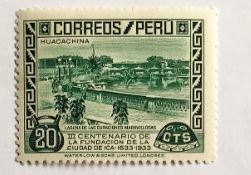
Small as they may be, stamps have long been used to commemorate events (e.g. anniversaries, sporting events, world observance days), prominent people (even fictional people such as James Bond), and diseases such as cancer and AIDS. It is therefore no surprise that malaria – a disease that has affected humankind (and other animals) for millennia – would have stamps created to mark landmark events and people. In his Review, Bernard Brabin explains how through them we have a unique record of malaria.
The 19th century saw big leaps in our understanding of malaria, the parasite that causes it and how it’s transmitted. Of the twenty investigators who contributed to this advance in our understanding, eleven had commemorative stamps issued by a national postage service (interestingly all of these were issued in the 20th century, many decades after the discoveries were made – and some not even in their home countries).

Amusingly (to me at least) some of the contention between investigators and their theories can be seen in the stamp designs. The Central African Republic’s postage stamp of 2015 shows Ronald Ross and Giovanni Grassi who held differing scientific views on the malaria parasite. In the 2015 postage stamp, Rossi and Grassi are represented equally – giving equal weight to both their views.
We often read of the mythical fountain of youth, but for a time a lake in Peru was credited with miraculous healing powers. It was found that cinchona trees had fallen in the lake during an earthquake – the bark of the trees contain quinine (which was isolated by Pierre Joseph Pelletier and Joseph Caventou) and shown to be the compound that alleviated fevers. The lake is commemorated in stamps too.

It was in the period between 1932 and 1954 that stamps were first used as a way of promoting malaria control information to the general public. The first such stamp was issued in Italy in 1932 encouraging land reclamation away from marshland (where malaria vectors thrived) and in 1939 Mexico issued an obligatory stamp depicting a man with a mosquito (highlighting the heavy burden of the disease). The money raised was used to cover a significant part of the costs of malaria control measures in Mexico.
In 1955, the WHO launched the first Global Malaria Eradication campaign and the accompanying stamps incorporated iconic malaria images in a variety of ways. For instance, Afghanistan issued a postage stamp showing insecticide spraying and, in India, a stamp incorporated an Anopheles mosquito, the caduceus staff of Hermes or Mercury and a factory (representing a DDT factory). These and various other stamps representing ‘Malaria eradication days’ or the ‘Destroy Malaria’ message were the forerunners for the WHO Malaria Eradication stamps initiative in 1962. Most stamps issued by participating nations incorporated the design of an Anopheles mosquito holding up a globe with the caduceus staff running up the centre of the globe. The 1962 initiative was deemed a widely successful advertising campaign for malaria eradication.
Between 1970 and 1995, the global emphasis shifted from malaria eradication to control, and the national stamps issued during this time reflect this. However, between 1996 to 2020 during the second global campaign, a new three-pronged eradication strategy was developed focusing on: aggressive control in endemic regions, progressive elimination to shrink the malaria map and research into vaccines, therapeutics, and vector control measures using newly developed technology. The stamps issued thus reflect a wider range of images: some incorporating scientific advances, others with instructions on usage of vector control methods, and some with powerful messaging such as Roll Back Malaria’s ‘Malaria: blood sweat and tears’. Stamps during this time were issued in sheets and targeted at collectors too – more so than previously.

Stamps have played important roles in not only marking events in malaria history, but as devices to spread awareness and information – and even raise money for control measures. Stamps are used almost universally (albeit at a lesser rate now with emails and messaging apps) and I feel are still an important, useful and iconic part of the malaria eradication narrative.

Comments